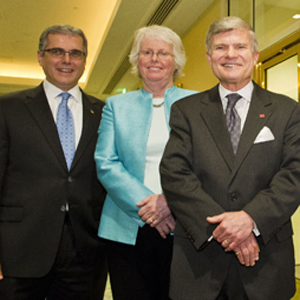When being fitted for braces or a bridge, many people have had the unpleasant experience of opening wide while a dentist plants warm goop over their teeth and instructs them, politely, to stay that way for a while. A gag-inducing, very long while.
Count those days as numbered. The Henry M. Goldman School of Dental Medicine is going all-digital. A technology upgrade is anticipated to improve both the way the school trains future dentists and dental specialists and the way its patient treatment centers keep patient records, take radiographs, create treatment plans, and deliver oral health care.
SDM Dean Jeffrey W. Hutter, the Spencer N. Frankl Professor in Dental Medicine, is a strong advocate for the move to what he calls “seamless digital dentistry.” He expects it will help attract the best students and faculty to the school and provide the best care to patients.
Hutter announced the school’s agreement with Sirona Dental Systems, Inc., last month at the annual meeting of the American Dental Association, in San Antonio, Tex. SDM is the first school in the country to go digital on such a wide scale.
“A long time in the making,” Hutter says, “this important initiative using Sirona Dental Systems, Inc., technology will allow the school to achieve its goal of implementing seamless digital dentistry into the clinical education we provide our students and residents and the oral health care we provide our patients.”
The move to all-digital dentistry follows months of careful consideration. Hutter appointed a task force to identify the school’s needs, headed by Russell Giordano, an SDM associate professor and director of biomaterials.
Once fully implemented, all patient data will feed into a comprehensive digital record. Intraoral digital images, intraoral exams, and digital scans of hard and soft tissues will then be accessible through a comprehensive record. Ancillary information such as photographs and CT, cone beam, cephalometric, panoramic, and facial scans will also be attached to the digital record. These data may be overlaid and interact to produce a complete digital representation of the patient, including 3-D renderings of the face. Students will then be able to plan comprehensive treatment without needing the physical presence of the patient, saving valuable patient time. Additionally, these data can be accessed remotely, allowing for consultation with experts around the globe.
Celeste Kong (SDM’84,’88), an SDM professor and acting chair of general dentistry, headed a separate task force that focused on how to properly incorporate the new technology into the school’s curriculum. She points out that students will be taught both traditional and digital methods for the near future. Kong believes students who graduate with both skill sets will be “even more sought out in the workplace.” She expects instruction to go fully digital within the coming years.
“Our students will graduate, and they will be setting the standard,” Hutter says.
As part of the initiative, SDM will also conduct comparative-effectiveness research on digital dentistry in both clinical and educational outcomes and will publish its findings. One research focus, Giordano says, will be on materials testing—determining the accuracy of the machines and the integrity of materials as they are milled, as well as developing new longer-lasting and versatile materials. Another research focus, says Kong, will be whether the digital systems improve students’ educational experience and patients’ clinical experience. She anticipates that students will acquire skills more quickly considering their around-the-clock access to the new technology. Student response has been positive so far, she says, and some are already asking, “How can we get more of this?”
Louis Brown (SDM’84,’91) is among the faculty fielding that question. The assistant professor, who has taught students how to build crowns in his introductory fixed prosthodontics class since 1992, thinks digital technology will improve teaching and learning.
Before the new digital equipment arrived, students carefully crafted their crowns, stood in line waiting for a faculty member to evaluate their work, noted any necessary changes, and placed finishing touches on the piece before cementing it onto a model jaw. If they wanted extra practice on the weekends—a crucial part of perfecting their professional skills—students often relied on one another’s untrained eyes to judge their work.
Brown says that scene has changed as of this semester. Students now scan their crown preparations, and using prepCheck® software, compare their work to a preprogrammed master design and correct their mistakes.
PrepCheck® “allows faculty to spend more time chairside with each student to focus on their specific needs and not necessarily have a line of other students waiting for a quick evaluation,” he says. He and his colleagues plan to use the application to grade practical exams, which he thinks will eliminate subjectivity in assessing students’ work.
Kali Stewart (SDM’15) recently used the digital systems to make a crown. She was impressed that she could take a digital impression of her patient’s mouth, manipulate a crown design, have the restoration or crown milled on-site, and cement it in place, all within a single appointment. The same procedure would have required an analog (aka goop) impression, off-site lab work, and several appointments using traditional techniques.
If given a choice, Stewart says, she and her colleagues prefer using the digital systems: “We’re in the digital age, so it just comes so easily and naturally.”
That’s the kind of positive student response Hutter was anticipating. He thinks patients will appreciate the difference too—and he should know. He’s the proud owner of two new digitally fabricated crowns.
“If I’m going to roll out an innovation for our patients,” he says with a grin, “I want to use it myself, too.”
















































Congratulation! I graduated from the prosthetic program in 1992 and now I am chief of Prosto – endo department at Universidad Javeriana in Bogotá, Colombia. We are also working in getting closer to digital dentistry. Next trip I would like to stop by and visit to see and learn more from your experience.
I am proud of being BU grad.